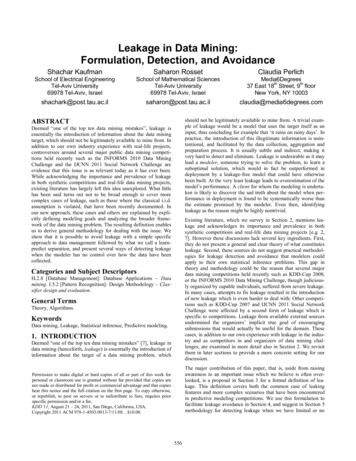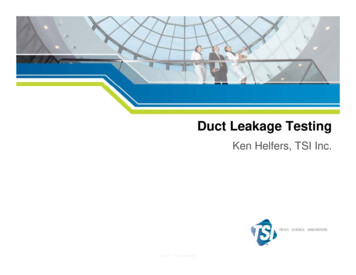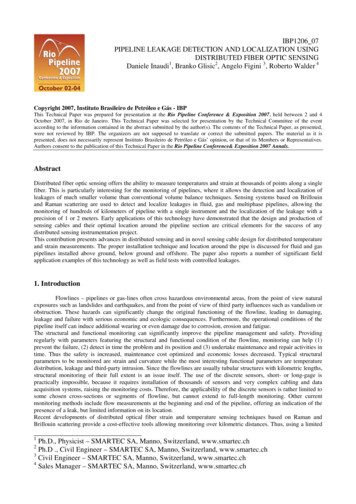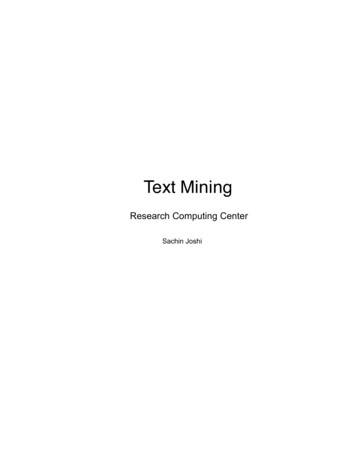
Transcription
Leakage in Data Mining:Formulation, Detection, and AvoidanceShachar KaufmanSaharon RossetClaudia PerlichSchool of Electrical EngineeringTel-Aviv University69978 Tel-Aviv, IsraelSchool of Mathematical SciencesTel-Aviv University69978 Tel-Aviv, IsraelMedia6Degreesthth37 East 18 Street, 9 floorNew York, NY claudia@media6degrees.comshould not be legitimately available to mine from. A trivial example of leakage would be a model that uses the target itself as aninput, thus concluding for example that „it rains on rainy days‟. Inpractice, the introduction of this illegitimate information is unintentional, and facilitated by the data collection, aggregation andpreparation process. It is usually subtle and indirect, making itvery hard to detect and eliminate. Leakage is undesirable as it maylead a modeler, someone trying to solve the problem, to learn asuboptimal solution, which would in fact be outperformed indeployment by a leakage-free model that could have otherwisebeen built. At the very least leakage leads to overestimation of themodel‟s performance. A client for whom the modeling is undertaken is likely to discover the sad truth about the model when performance in deployment is found to be systematically worse thanthe estimate promised by the modeler. Even then, identifyingleakage as the reason might be highly nontrivial.ABSTRACTDeemed “one of the top ten data mining mistakes”, leakage isessentially the introduction of information about the data miningtarget, which should not be legitimately available to mine from. Inaddition to our own industry experience with real-life projects,controversies around several major public data mining competitions held recently such as the INFORMS 2010 Data MiningChallenge and the IJCNN 2011 Social Network Challenge areevidence that this issue is as relevant today as it has ever been.While acknowledging the importance and prevalence of leakagein both synthetic competitions and real-life data mining projects,existing literature has largely left this idea unexplored. What littlehas been said turns out not to be broad enough to cover morecomplex cases of leakage, such as those where the classical i.i.d.assumption is violated, that have been recently documented. Inour new approach, these cases and others are explained by explicitly defining modeling goals and analyzing the broader framework of the data mining problem. The resulting definition enablesus to derive general methodology for dealing with the issue. Weshow that it is possible to avoid leakage with a simple specificapproach to data management followed by what we call a learnpredict separation, and present several ways of detecting leakagewhen the modeler has no control over how the data have beencollected.Existing literature, which we survey in Section 2, mentions leakage and acknowledges its importance and prevalence in bothsynthetic competitions and real-life data mining projects [e.g. 2,7]. However these discussions lack several key ingredients. First,they do not present a general and clear theory of what constitutesleakage. Second, these sources do not suggest practical methodologies for leakage detection and avoidance that modelers couldapply to their own statistical inference problems. This gap intheory and methodology could be the reason that several majordata mining competitions held recently such as KDD-Cup 2008,or the INFORMS 2010 Data Mining Challenge, though judiciously organized by capable individuals, suffered from severe leakage.In many cases, attempts to fix leakage resulted in the introductionof new leakage which is even harder to deal with. Other competitions such as KDD-Cup 2007 and IJCNN 2011 Social NetworkChallenge were affected by a second form of leakage which isspecific to competitions. Leakage from available external sourcesundermined the organizers‟ implicit true goal of encouragingsubmissions that would actually be useful for the domain. Thesecases, in addition to our own experience with leakage in the industry and as competitors in and organizers of data mining challenges, are examined in more detail also in Section 2. We revisitthem in later sections to provide a more concrete setting for ourdiscussion.Categories and Subject DescriptorsH.2.8 [Database Management]: Database Applications – Datamining. I.5.2 [Pattern Recognition]: Design Methodology – Classifier design and evaluation.General TermsTheory, Algorithms.KeywordsData mining, Leakage, Statistical inference, Predictive modeling.1. INTRODUCTIONDeemed “one of the top ten data mining mistakes” [7], leakage indata mining (henceforth, leakage) is essentially the introduction ofinformation about the target of a data mining problem, whichThe major contribution of this paper, that is, aside from raisingawareness to an important issue which we believe is often overlooked, is a proposal in Section 3 for a formal definition of leakage. This definition covers both the common case of leakingfeatures and more complex scenarios that have been encounteredin predictive modeling competitions. We use this formulation tofacilitate leakage avoidance in Section 4, and suggest in Section 5methodology for detecting leakage when we have limited or noPermission to make digital or hard copies of all or part of this work forpersonal or classroom use is granted without fee provided that copies arenot made or distributed for profit or commercial advantage and that copiesbear this notice and the full citation on the first page. To copy otherwise,or republish, to post on servers or to redistribute to lists, requires priorspecific permission and/or a fee.KDD’11, August 21 – 24, 2011, San Diego, California, USA.Copyright 2011 ACM 978-1-4503-0813-7/11/08 10.00.556
ing the "heavy spender". The idea is that it is better to ask analytical questions that have a clear temporal cause-and-effect structure.Of course leaks are still possible, but much harder to introduce byaccident and much easier to identify. We return to this idea inSection 3. A later paper by the authors [4] reiterates the previousdiscussion, and adds the example of the “use of free shipping”,where a leak is introduced when free shipping is provided as aspecial offer with large purchases.control over how the data have been collected. This methodologyshould be particularly useful for practitioners in predictive modeling problems, as well as for prospective competition organizers.2. LEAKAGE IN THE KDD LITERATUREThe subject of leakage has been visited by several data miningtextbooks as well as a few papers. Most of the papers we refer toare related to KDD-Cup competitions, probably due to authors ofworks outside of competitions locating and fixing leakage issueswithout reporting the process. We shall give a short chronologicalreview here while collecting examples to be used later as casestudies for our proposed definition of leakage.Rosset et al. [11] discuss leakage encountered in the 2007 KDDCup competition. In that year's contest there were two relatedchallenges concerning movie viewers‟ reviews from the famousNetflix database. The first challenge, "Who Reviewed What", wasto predict whether each user would give a review for each title in2006, given data up to 2005. The second challenge, "How ManyReviews", was to predict the number of reviews each title wouldreceive in 2006, also using data given up to 2005. For the firstchallenge, a test set with actual reviews from 2006 was provided.Although disjoint sets of titles were used to construct the data setsfor these two challenges, Rosset et al.‟s winning submission managed to use the test set for the first problem as the target in asupervised-learning modeling approach for the second problem.This was possible due to a combination of two facts. First, up to ascaling factor and noise, the expected number of user/review pairsin the first problem's test set in which a title appears is equal to thetotal number of reviews which that titled received in 2006. This isexactly the target for the second problem, only on different titles.Second, the titles are similar enough to share statistical properties,so from the available dynamics for the first group of titles one caninfer the dynamics of the second group‟s. We shall revisit thiscomplex example in Section 3, where this case will motivate us toextend our definition of leakage beyond leaking features.Pyle [9, 10, 11] refers to the phenomenon which we call hereleakage, in the context of predictive modeling, as Anachronisms(something that is out of place in time), and says that "too good tobe true" performance is "a dead giveaway" of its existence. Theauthor suggests turning to exploratory data analysis in order tofind and eliminate leakage sources, which we will also discuss inSection 5. Nisbet et al. [7] refer to the issue as "leaks from thefuture” and claim it is "one of the top 10 data mining mistakes".They repeat the same basic insights, but also do not suggest ageneral definition or methodology to correct and prevent leakage.These titles provide a handful of elementary but common examples of leakage. Two representative ones are: (i) An "accountnumber" feature, for the problem of predicting whether a potentialcustomer would open an account at a bank. Obviously, assignmentof such an account number is only done after an account has beenopened. (ii) An "interviewer name" feature, in a cellular companychurn prediction problem. While the information “who interviewed the client when they churned” appears innocent enough, itturns out that a specific salesperson was assigned to take overcases where customers had already notified they intend to churn.Two medical data mining contests held the following year andwhich also exhibited leakage are discussed in [7, 13]. KDD-Cup2008 dealt with cancer detection from mammography data. Analyzing the data for this competition, the authors point out that the“Patient ID” feature (ignored by most competitors) has tremendous and unexpected predictive power. They hypothesize that multiple clinical study, institution or equipment sources were used tocompile the data, and that some of these sources were assignedtheir population with prior knowledge of the patient‟s condition.Leakage was thus facilitated by assigning consecutive patient IDsfor data from each source, that is, the merge was done withoutobfuscating the source. The INFORMS Data Mining Challenge2008 competition held the same year, addressed the problem ofpneumonia diagnosis based on patient information from hospitalrecords. The target was originally embedded as a special value ofone or more features in the data given to competitors. The organizers removed these values, however it was possible to identifytraces of such removal, constituting the source of leakage in thisexample (e.g. a record with all condition codes missing, similarlyto Kohavi‟s jewelry example).Kohavi et al. [2] describe the introduction of leaks in data miningcompetitions as giveaway attributes that predict the target becausethey are downstream in the data collection process. The authorsgive an example in the domain of retail website data analyticswhere for each page viewed the prediction target is whether theuser would leave or stay to view another page. A leaking attributeis the "session length", which is the total number of pages viewedby the user during this visit to the website. This attribute is addedto each page-view record at the end of the session. A solution is toreplace this attribute with "page number in session" which describes the session length up to the current page, where predictionis required.Subsequent work by Kohavi et al. [3] presents the common business analysis problem of characterizing big spenders among customers. The authors explain that this problem is prone to leakagesince immediate triggers of the target (e.g. a large purchase orpurchase of a diamond) or consequences of the target (e.g. payinga lot of tax) are usually available in collected data and need to bemanually identified and removed. To show how correcting forleakage can become an involved process, the authors also discussthe more complex situation where removing the information "totalpurchase in jewelry" caused information of "no purchases in anydepartment" to become fictitiously predictive. This is becauseeach customer found in the database is there in the first place dueto some purchase, and if this purchase is not in any department(still available), it has to be jewelry (which has been removed).They suggest defining analytical questions that should suffer lessfrom leaks – such as characterizing a "migrator" (a user who is alight spender but will become a heavy one) instead of characteriz-Also in the recent work by Rosset et al. [13], the concept of identifying and harnessing leakage has been openly addressed as oneof three key aspects for winning data mining competitions. Thiswork provides the intuitive definition of leakage as "The unintentional introduction of predictive information about the target bythe data collection, aggregation and preparation process". Theauthors mention that leakage might be the cause of many failuresof data mining applications, and give the illustrative example ofpredicting people who are likely to be sick by looking at how557
many work days they would end up missing. They also describe areal-life business intelligence project at IBM where potentialcustomers for certain products were identified, among otherthings, based on keywords found on their websites. This turnedout to be leakage since the website content used for training hadbeen sampled at the point in time where the potential customer hasalready become a customer, and where the website containedtraces of the IBM products purchased, such as the word “Websphere” (e.g. in a press release about the purchase or a specificproduct feature the client uses).modeling. However, none of the discussions that we could findhas addressed the issue in a general way, or suggested methodology for handling it. In the following section we make our attempt toderive a definition of leakage.3. FORMULATION3.1 Preliminaries and LegitimacyIn our discussion of leakage we shall define the roles of client andmodeler as in Section 1, and consider the standard statistical inference framework of supervised learning and its generalizations,where we can discuss examples, targets and features. We assumethe reader is familiar with these concepts. For a complete reference see [1]. Let us just lay out our notation and say that in ourframework we receive from an axiomatic data preparation stage amultivariate random process.is the outcome ortarget generating process with samples target instances. Valuesor realizations of the random variable are denoted (in bold).Similarly, , and are the feature-vector generating process,an instance and realization. For individual feature generatingprocesses, instances and realizations we use,and. Specific instancesandtaken from the same instanceofare said to be -related. The modeler‟s goal is to statistically infer a target instance, from its associated feature-vector instance inand from a separate group of samples of , calledthe training examples. The solution to this problem is a model. We say that the model‟s observational inputsfor predicting areand, and this relation between thevarious elements in the framework is the base for our discussion.The latest INFORMS and IJCNN competitions held in late 2010and early 2011 are fresh examples of how leakage continues toplague predictive modeling problems and competitions in particular. The INFORMS 2010 Data Mining Challenge required participants to develop a model that predicts stock price movements,over a fixed one-hour horizon, at five minute intervals. Competitors were provided with intraday trading data showing stock prices, sectoral data, economic data, experts' predictions and indices.The data were segmented to a training database, on which participants were expected to build their predictive models, and a testdatabase which was used by the organizers to evaluate submissions. The surprising results were that about 30 participatinggroups achieved more than 0.9 AUC, with the best model surpassing 0.99 AUC. Had these models been legitimate they would‟veindeed made a “big impact on the finance industry” as the organizers had hoped, not to mention making their operators verywealthy individuals. Unfortunately, however, it became clear thatalthough some steps had been taken to prevent competitors from“looking up the answers” (the underlying target stock‟s identitywas not revealed, and the test set did not include the variablebeing predicted), it was still possible to build models that rely ondata from the future. Having data from the future for the explanatory variables, some of which are highly cointegrated with thetarget (e.g. a second stock within the same sector as the targetstock), and having access to publicly available stock data such asYahoo/Google Finance (which allows finding at least good candidates for the identity of the target stock, consequently revealing alltest values) was the true driver of success for these models. Theorganizers held two rankings of competitors, one where futureinformation was allowed and another where it was forbidden,however in the end they had to admit that verifying future information was not used was impossible, and that it was probable thatall models were tainted, as all modelers had been exposed to thetest set.Models containing leaks are a subclass of the broader concept ofillegitimate or unacceptable models. At this level, legitimacy,which is a key concept in our formulation of leakage, is completely abstract. Every modeling problem sets its own rules for whatconstitutes a legitimate or acceptable solution and different problems, even if using the same data, may have wildly different viewson legitimacy. For example a solution could be considered illegitimate if it is too complex – say if it uses too many features or if itis not linear in its features.However our focus here is on leakage, which is a specific form ofillegitimacy that is an intrinsic property of the observational inputsof a model. This form of illegitimacy remains partly abstract, butcould be further defined as follows: Let be some random variable. We say a second random variable is -legitimate if isobservable to the client for the purpose of inferring In this casewe write.The IJCNN 2011 Social Network Challenge presented participantswith anonymized 7,237,983 edges from an undisclosed onlinesocial network and asked to predict which of an additional set of8,960 potential edges are in fact realized on the network as well.The winners have recently reported [3] they had been able torecognize, through sophisticated analysis, that the social networkin question was Flickr and then to de-anonymize the majority ofthe data. This allowed them to use edges available from the online Flickr network to correctly predict over 60% of edges whichwere identified, while the rest had to be handled classically usinglegitimate prediction. Similarly to other cases that have beenmentioned, these rogue solutions are sometimes so elegant andinsightful that they carry merit in their own right. The problem isthat they do not answer the original question presented by theorganizers.A fully concrete meaning of legitimacy is built-in to any specificinference problem. The trivial legitimacy rule, going back to thefirst example of leakage given in Section 1, is that the target itselfmust never be used for inference:(1)We could use this rule if we wanted to disqualify the winningsubmission to the IJCNN 2011 Social Network Challenge, for it,however cleverly, eventually uses some of the targets themselvesfor inference. This condition should be abided by all problems,and we refrain from explicitly mentioning it for the remainingexamples we shall discuss.Naturally, a model contains leaks with respect to a target instanceif one or more of its observational inputs are -illegitimate. Wesay that the model inherits the illegitimacy property from theClearly, then, the issue of leakage has been observed in variouscontexts and problem domains, with a natural focus on predictive558
features and training examples it uses. The discussion proceedsalong these two possible sources of leakage for a model: featuresand training examples.(5).We can think of a requirement to use exactlyspecified poolof preselected features:3.2 Leaking Featuresfeatures from a,(6)We begin with the more common case of leaking features. Firstwe must extend our abstract definition of legitimacy to the case ofrandom processes: Letbe some random process. We say asecond random processis -legitimate if, for every pair ofinstances of and , and respectively, which are -related,is -legitimate. We use the same notation as we did for randomvariables in 3.1, and write that.and so on. In fact, there is a variant of example (6) which is verycommon: only the featuresselected for a specific provideddataset are considered legitimate. Sometimes this rule allows freeuse of the entire set:Leaking features are then covered by a simple condition for theabsence of leakage:Usually however this rule is combined with (3) to give:.(2).The prevailing example for this type of leakage is what we call theno-time-machine requirement. In the context of predictive modeling, it is implicitly required that a legitimate model only build onfeatures with information from a time earlier (or sometimes, nolater) than that of the target. Formally, and , made scalar forthe sake of simplicity, are random processes over some time axis(not necessarily physical time). Prediction is required by the clientfor the target process at times , and their -related featureprocess is observable to the client at times . We then have:It is easy to see how conditions (2) and (3) similarly apply to theaccount number and interviewer name examples from [10], thesession length of [2] (while the corrected “page number in session” is fine), the immediate and indirect triggers described in [3,4], the remaining competitions described in [8, 13], and the website based features used by IBM and discussed in [13]. Howevernot all examples fall under condition (2).(3)Such a rule should be read: Any legitimate feature w.r.t. the targetprocess is a member of the right hand side set of features. In thiscase the right hand side is the set of all features whose every instance is observed earlier than its -related target instance. Weare assuming with this notation thatcontains all possible features, and use “ ” to express that additional legitimacy constraintsmight also apply (otherwise “ ” could be used).Let us examine the case mentioned earlier of KDD-Cup 2007 asdiscussed in [11]. While clearly taking advantage of informationfrom reviews given to titles during 2006 (the mere fact of usingdata from the future is proof, but we can also see it in action bythe presence of measurable leakage – the fact that this modelperformed significantly better both in internal tests and the finalcompetition), the final delivered modeldoes not include anyillegitimate feature1. To understand what has transpired, we mustaddress the issue of leakage in training examples.While the simple no-time-machine requirement is indeed the mostcommon case, one could think of additional scenarios which arestill covered by condition (2). A simple extension is to requirefeatures to be observable a sufficient period of time prior toasin (4) below in order to preclude any information that is an immediate trigger of the target. One reason why this might be necessaryis that sometimes it is too limiting to think of the target as pertaining to a point-in-time, only to a rough interval. Using data observable close tomakes the problem uninteresting. Such is the casefor the “heavy spender” example from [3]. With legitimacy defined as (3) (or as (4) when) a model may be built that usesthe purchase of a diamond to conclude that the customer is a bigspender but with sufficiently large this is not allowed. Thistransforms the problem from identification of “heavy spenders” tothe suggested identification of “migrators”.(8)Most documented cases of leakage mentioned in Section 2 arecovered by condition (2) in conjunction with a no-time-machinerequirement as in (3). For instance, in the trivial example of predicting rainy days, the target is an illegitimate feature since itsvalue is not observable to the client when the prediction is required (say, the previous day). As another example, the pneumonia detection database in the INFORMS 2008 challenge discussedin [8, 13] implies that a certain combination of missing diagnosiscode and some other features is highly informative of the target.However this feature is illegitimate, as the patient‟s condition isstill being studied.That is, any feature made available by the data preparation processis deemed legitimate by the precise formulation of the modelingproblem at hand, instance by instance w.r.t. its matching target.(7).3.3 Leakage in Training ExamplesLet us first consider the following synthetic but illustrative example. Suppose we are trying to predict the level of a white noiseprocessfor, clearly a hopeless task.Suppose further that for the purpose of predicting , itself is alegitimate feature but otherwise, as in (3), only past information isdeemed legitimate – so obviously we cannot cheat. Now considera model trained on examplestaken from.The proposed model is, a table containing foreach the target‟s realized value . Strictly speaking, the only(4)Another example, using the same random process notation, is amemory limitation, where a model may not use information olderthan a time relative to that of the target:1559In fact the use of external sources that are not rolled-back to2005, such as using current (2007) IMDB data, is simple leakage just like in the IBM example. However this is not the major source of leakage in this example.
feature used by this model, , is legitimate. Hence the model hasno leakage as defined by condition (2), however it clearly hasperfect prediction performance for the evaluation set in the example. We would naturally like to capture this case under a completedefinition of leakage for this problem.have been completely legitimate. In some domains such as timeseries prediction, where typically only a single history measuringthe phenomenon of interest is available for analysis, this form ofleakage is endemic and commonly known as data snooping /dredging [5].In order to tackle this case, we suggest adding to (2) the followingcondition for the absence of leakage: For all,Regarding concretization of legitimacy for a new problem: Arguably, more often than not the modeler might find it very challenging to define, together with the client, a complete set of suchlegitimacy guidelines prior to any modeling work being undertaken, and specifically prior to performing preliminary evaluation.Nevertheless it should usually be rather easy to provide a coarsedefinition of legitimacy for the problem, and a good place to startis to consider model use cases. The specification of any modelingproblem is really incomplete without laying out these ground rulesof what constitutes a legitimate model.(9)2whereis the set of evaluation target instances, andarethe sets of training targets and feature-vectors respectively whoserealizations make up the set of training examples.One way of interpreting this condition is to think of the information presented for training as constant features embedded into themodel, and added to every feature-vector instance the model iscalled to generate a prediction for.As a final point on legitimacy, let us mention that once it has beenclearly defined for a problem, the major challenge becomes preparing the data in such a way that ensures models built on thisdata would be leakage free. Alternatively, when we do not havefull control over data collection or when it is simply given to us, amethodology for detecting when a large number of seeminglyinnocent pieces of information are in fact plagued with leakage isrequired. This shall be the focus of the following two sections.For modeling problems where the usual i.i.d. instances assumption is valid, and when without loss of generality considering allinformation specific to the instance being predicted as featuresrather than examples, condition (9) simply reduces to condition (2) since irrelevant observations can always be considered legitimate. In contrast, when dealing with problems exhibiting nonstationarity, a.k.a. concept-drift [15], and more specifically thecase when samples of the target (or, within a Bayesian framework,the target/feature) are not mutually independent, condition (9)cannot be reduced to condition (2). Such is the case of KDD-Cup2007. Available information about the number of reviews given toa group of titles for the “who reviewed what” task is not statistically independent of the number of reviews given to the secondgroup of titles which is the target in the “how many ratings” task.The reason for this is that these reviews are all given by the samepopulation of users over the same period in 2006, and thus aremutually affected by shared causal ancestors such as viewing andparticipation trends (e.g. promotions, similar media or event thatgets a lot of exposure and so on). Without proper conditioning onthese shared ancestors we have potential dependence, and becausemost of these ancestors are unobservable, and difficult to findobservable proxies for, dependence is bound to occur.4. AVOIDANCE4.1 MethodologyOur suggested methodology for avoiding leakage is a two stageprocess of tagging every observation with legitimacy tags duringcollection and then observing what we call a learn-predict separation. We shall now describe these stages and then provide someexamples.At the most basic level suitable for handling the more general caseof leakage in trai
Data mining, Leakage, Statistical inference, Predictive modeling. 1. INTRODUCTION . Deemed "one of the top ten data mining mistakes" [7], leakage in data mining (henceforth, leakage) is essentially the introduction of information about the target of a data mining problem, which should not be legitimately available to mine from.










